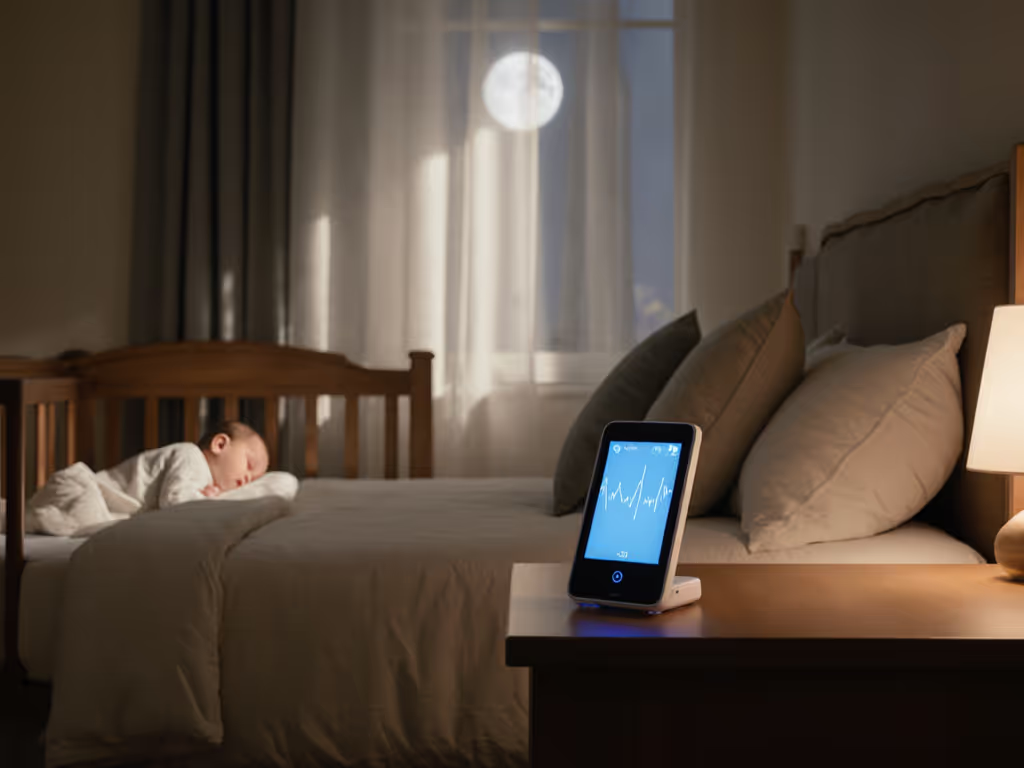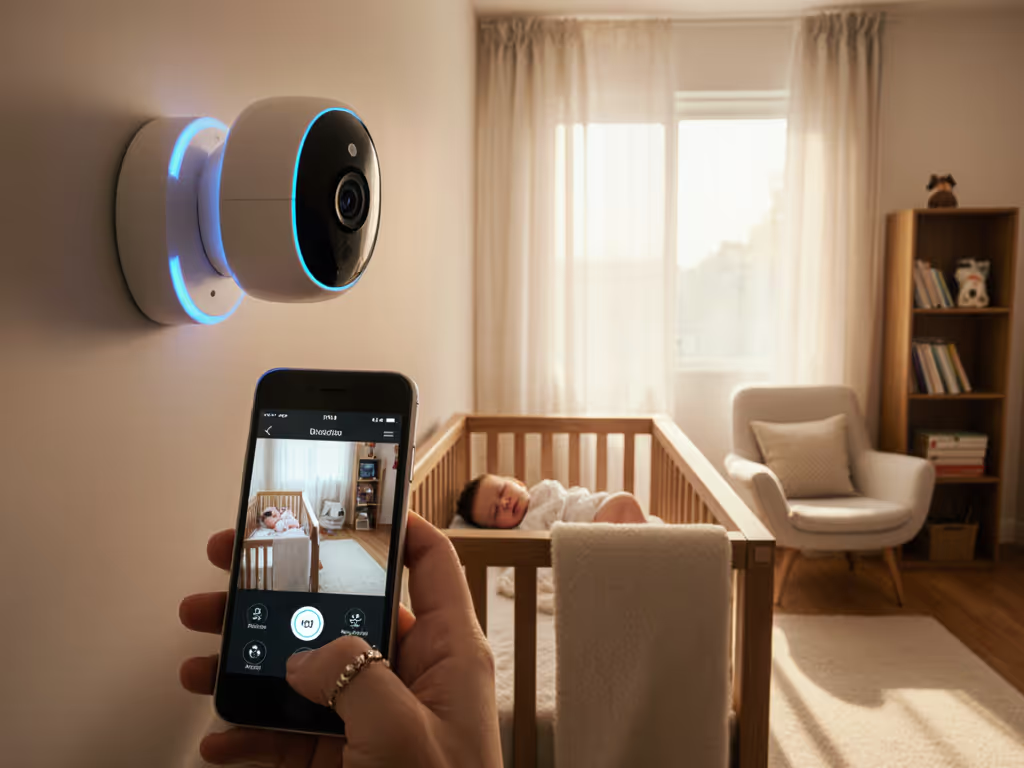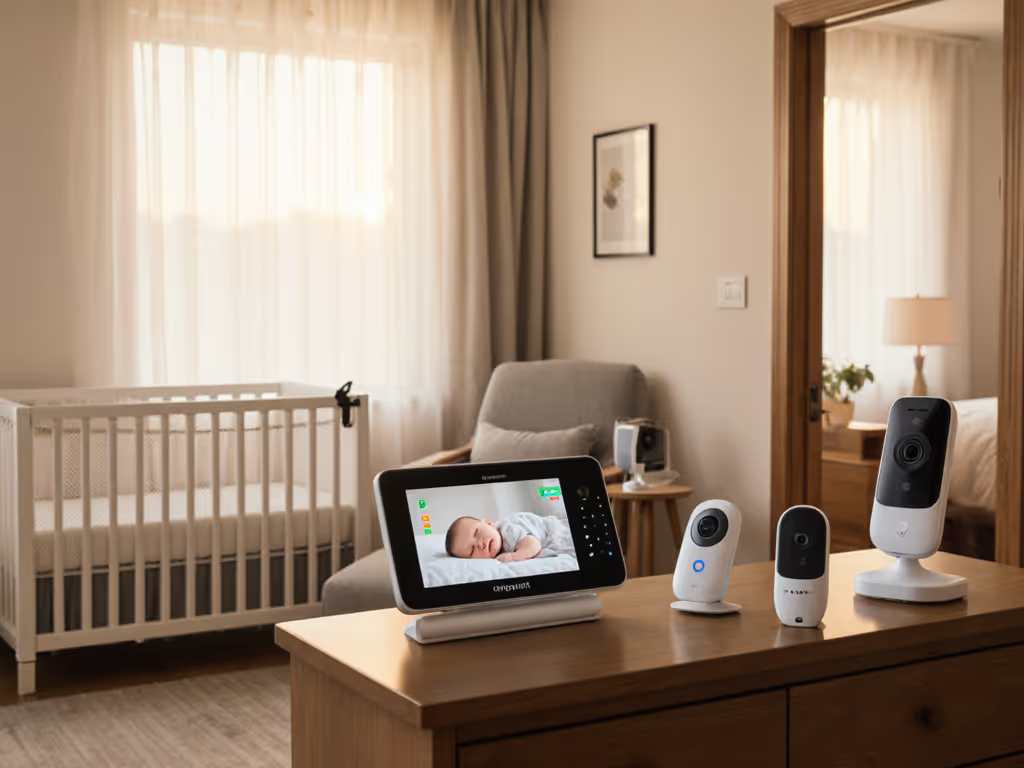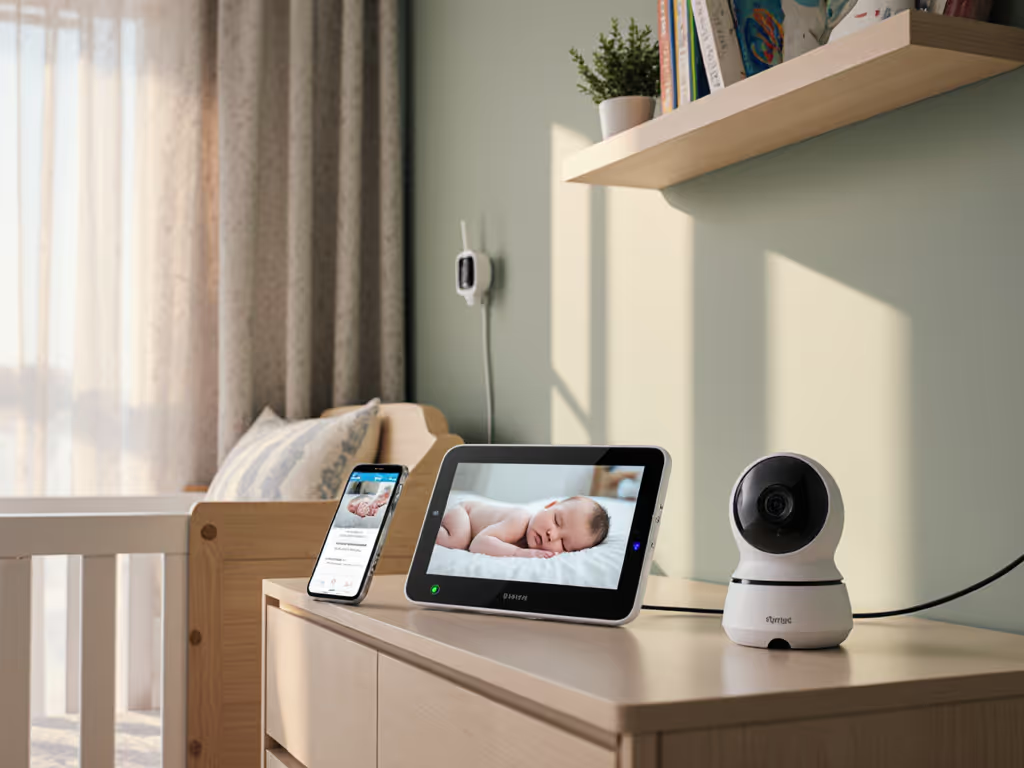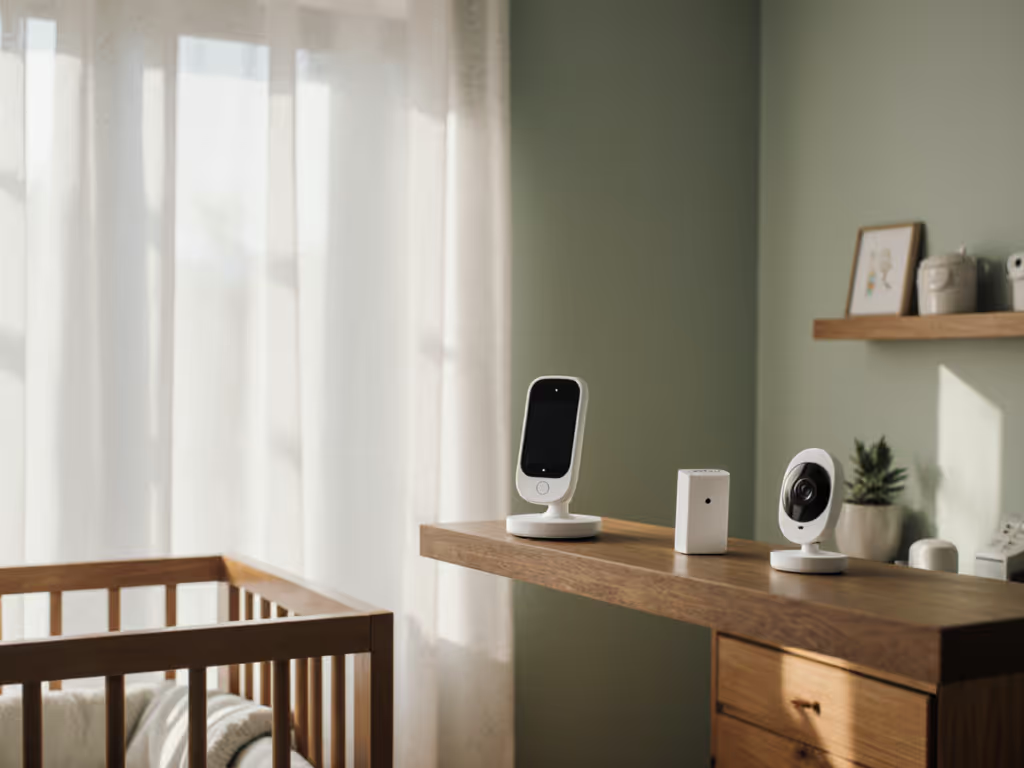
7 Types of Baby Monitors Every Parent Should Know
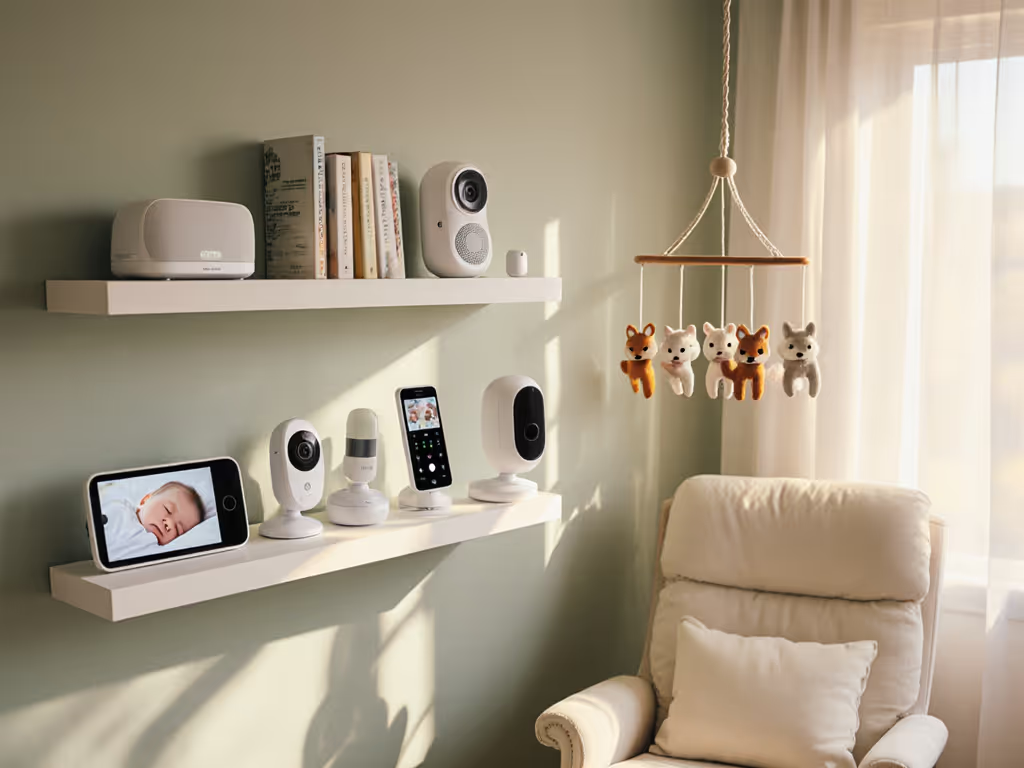
Did you know that over 90 percent of new parents use a baby monitor for extra peace of mind? The right device can make all the difference when it comes to keeping your baby safe and feeling connected, even from another room. Choosing between audio, video, smart, and wearable monitors means weighing safety, privacy, and convenience so you can focus on what matters most—a sound sleep for you and your little one.
Quick Summary
| Takeaway | Explanation |
|---|---|
| 1. Choose the right type of monitor | Determine whether you need audio, video, WiFi, or non-WiFi options based on personal monitoring preferences. |
| 2. Prioritize security with non-WiFi monitors | Non-WiFi monitors ensure privacy by avoiding internet connectivity and potential hacking risks. |
| 3. Consider wearable monitors for health tracking | Wearable monitors provide real-time data on baby's health indicators like movement and breathing, enhancing safety. |
| 4. Evaluate video monitors for visual assurance | Video monitors offer real-time visual access, aiding in safe supervision while minimizing sleep disruptions. |
| 5. Integrate smart monitors for home automation | Smart monitors enhance convenience with automation features such as environmental tracking and voice control. |
1. Audio Baby Monitors: Simple and Reliable Options
Audio baby monitors represent the classic approach to keeping an ear out for your little one. These straightforward devices transmit sounds from your baby's room directly to a parent unit, allowing you to hear every whimper, cry, or soft movement without being physically present in the room.
How Audio Baby Monitors Work transforms monitoring from guesswork into a clear communication channel. By using radio frequency or digital transmission technology, these monitors pick up sounds through a sensitive microphone placed near your baby and broadcast them to a receiver you can carry around your home. Parents gain real peace of mind knowing they can hear their child instantly.
The primary advantage of audio monitors lies in their simplicity and reliability. Unlike more complex video or smart monitors, these devices focus on one critical task: sound transmission. They typically offer:
- Crystal clear sound quality
- Long battery life on parent units
- Lightweight and portable design
- Affordable pricing compared to advanced monitoring systems
Practical Selection Tips: When choosing an audio baby monitor, consider factors like range (how far the signal reaches), battery duration, and potential interference from other electronic devices. Look for models with adjustable volume and possibly a vibration alert for moments when you cannot hear the audio clearly.
"Audio baby monitors provide clear sound transmission, enabling parents to hear their baby's sounds from another room." - Baby Sense Monitors Research
While technology continues to advance, audio monitors remain a trusted option for parents seeking a no nonsense monitoring solution that keeps them connected to their baby's acoustic world.
2. Video Baby Monitors: Real-Time Visual Monitoring
Imagine having eyes in your baby's room even when you are not physically present. Video baby monitors transform parental surveillance from audio guesswork to crystal clear visual confirmation. These technological sentinels provide parents with a comprehensive monitoring solution that goes beyond simple sound tracking.
How Video Monitors Work represents a significant leap in childcare technology. These devices utilize digital cameras strategically placed in the baby's room that transmit high resolution images to a dedicated parent screen. Modern models offer remarkable features like wide angle views, zoom capabilities, and night vision that allow you to see your baby clearly even in complete darkness.
The core advantages of video baby monitors include:
- Real time visual tracking
- High definition video streams
- Night vision capabilities
- Multiple camera angle options
- Secure encrypted transmission
Practical Monitoring Strategies involve selecting a monitor with features matching your specific home environment. Consider factors like room size, camera placement, and potential signal interference. Some advanced models even offer smartphone connectivity allowing parents to check on their little one from virtually anywhere.
"Modern video baby monitors offer high-quality video resolution, providing clear visuals of the baby's crib." - Natural Baby Shower Research
While video monitors represent a more sophisticated approach to child monitoring, they provide an unparalleled sense of security. Parents gain the ability to visually confirm their baby's safety without disrupting precious sleep moments.
3. WiFi Baby Monitors: Remote Access and Smart Features
WiFi baby monitors represent the pinnacle of modern parental monitoring technology. These intelligent devices transform your smartphone into a powerful surveillance tool that connects you directly to your baby's world no matter where you are.
How WiFi Monitors Function leverages internet connectivity to provide unprecedented monitoring flexibility. By using secure wireless networks, these monitors transmit high definition video streams and audio directly to your mobile device. Parents gain the extraordinary ability to check on their child from work, while traveling, or simply from another room in the house.
The standout features of WiFi baby monitors include:
- Real time video streaming
- Smartphone app integration
- Motion and sound detection alerts
- Multi camera support
- Cloud storage options for video recording
Smart Monitoring Strategies involve selecting a system with robust security protocols. Look for monitors that offer encrypted connections and password protection to prevent unauthorized access. Consider bandwidth requirements and ensure your home internet can support consistent high quality video transmission.
"WiFi baby monitors enable parents to watch over their child via a video app on their phone or tablet, providing remote access" - YouAreMom Research
While these monitors offer incredible convenience, parents should balance technological connectivity with personal interaction. WiFi monitors are tools that supplement parental care not replace the irreplaceable human connection between caregiver and child.
4. Non-WiFi Baby Monitors: Enhanced Privacy Protection
In an era of increasing digital vulnerability, non-WiFi baby monitors emerge as the gold standard for parents prioritizing security and privacy. These innovative devices provide a secure monitoring solution that keeps hackers and digital intruders at bay.
How Non-WiFi Monitors Work leverages advanced Frequency-Hopping Spread Spectrum (FHSS) technology to create an impenetrable communication channel. Unlike internet-connected monitors, these devices transmit signals through dedicated radio frequencies that constantly change channels. This dynamic approach makes unauthorized access virtually impossible.
The key advantages of non-WiFi baby monitors include:
- Zero internet dependency
- Encrypted signal transmission
- No cloud storage requirements
- Reduced electromagnetic exposure
- Instant local connection
Privacy Protection Strategies involve selecting monitors with robust encryption and minimal digital footprint. Look for models that offer local transmission only, avoiding any potential cloud storage risks. Parents gain peace of mind knowing their baby's moments remain completely private and secure.
"Non-WiFi baby monitors offer zero hacking risk and no monthly cloud fees, providing a secure and private monitoring solution" - Baby Sense Monitors Research
While technology continues to evolve, non-WiFi monitors represent a thoughtful approach to child monitoring. They balance technological sophistication with fundamental parental needs: safety, privacy, and uninterrupted connection.
5. Wearable Baby Monitors: Health and Movement Tracking
Wearable baby monitors represent a quantum leap in infant monitoring technology. These sophisticated devices transform parental vigilance from passive observation to active health tracking by providing unprecedented insights into your baby's physiological patterns.
How Wearable Monitors Function involves advanced sensor technology that tracks critical health indicators. Typically worn as soft ankle bands or attached to clothing, these monitors collect real time data about your baby's movement, breathing rate, heart rate, and sleep patterns. Some models use sophisticated vision based algorithms to detect subtle neurodevelopmental cues without direct physical contact.
The remarkable features of wearable baby monitors include:
- Continuous health monitoring
- Immediate movement alerts
- Breathing pattern tracking
- Sleep cycle analysis
- Temperature sensing capabilities
Strategic Health Monitoring requires selecting a device that balances technological sophistication with comfort. Look for monitors with soft materials, adjustable sizing, and reliable transmission capabilities. These devices provide parents with an additional layer of reassurance beyond traditional monitoring methods.
"Wearable baby monitors come with sensor pads that alert parents if no movement is detected for a certain period" - EuroSchool India Research
While wearable monitors offer incredible technological advantages, they should complement not replace traditional parental care and medical professional guidance. They represent a powerful tool in understanding your baby's health and development.
6. Smart Baby Monitors: Integration with Home Automation
Imagine a nursery that thinks and responds like a digital guardian. Smart baby monitors represent the cutting edge of parental technology, transforming your baby's room into an intelligent ecosystem of safety and comfort.
How Smart Monitoring Systems Function goes beyond traditional surveillance. These sophisticated devices integrate seamlessly with home automation platforms, creating a comprehensive network that monitors temperature, humidity, sound levels, and even plays soothing lullabies with a simple voice command. Parents gain unprecedented control and insight into their baby's environment through interconnected smart technologies.
The revolutionary features of smart baby monitors include:
- Real time environmental tracking
- Two way audio communication
- Automated lullaby and white noise playback
- Temperature and humidity sensors
- Voice assistant compatibility
Strategic Home Integration involves selecting monitors that communicate with existing smart home ecosystems. Consider devices that offer flexible connectivity with platforms like Amazon Alexa or Google Home. Look for systems that provide granular control and customizable alerts tailored to your specific parenting needs.
"Smart baby monitors integrate with home automation systems, offering features like temperature and humidity monitoring, two-way talk, and lullaby playback" - Baby Sense Monitors Research
While technology continues to evolve, smart baby monitors represent more than just a gadget. They are comprehensive care solutions that empower parents with information, convenience, and peace of mind.
7. Movement and Breathing Monitors: Peace of Mind for Parents
For parents who want to transform anxiety into actionable monitoring, movement and breathing monitors represent a technological breakthrough in infant care. These sophisticated devices offer an unprecedented window into your baby's physiological well being.
How Movement Monitors Function leverages advanced sensor technology to track even the most subtle infant movements. By using precision sensor pads placed under the mattress or wearable devices, these monitors create a continuous vigilance system that alerts parents to any interruptions in breathing or movement patterns. Cutting edge vision based algorithms now enable non contact monitoring of infant behaviors with remarkable accuracy.
The critical features of movement and breathing monitors include:
- Continuous physiological tracking
- Immediate alerts for movement cessation
- Breathing pattern analysis
- Non invasive monitoring techniques
- Detailed sleep cycle reporting
Strategic Monitoring Approaches involve selecting devices that balance technological sophistication with comfort. Choose monitors that provide granular data without creating additional stress. Look for systems with customizable sensitivity settings that match your specific monitoring needs.
"Movement monitors come with sensor pads that alert parents if no movement is detected for a certain period" - EuroSchool India Research
While these monitors provide extraordinary insights, they should complement traditional parental care and medical guidance. They represent a powerful tool in understanding infant health patterns while offering parents unprecedented peace of mind.
This table summarizes different types of baby monitors, highlighting their features, benefits, and ideal use scenarios.
| Monitor Type | Features & Technology | Best For |
|---|---|---|
| Audio Monitors | Simple sound transmission, long battery life, affordable | Parents who prefer simplicity and reliability |
| Video Monitors | High-definition video, night vision, multiple angles | Visual monitoring with enhanced security |
| WiFi Monitors | Remote access via apps, motion/sound alerts, cloud storage | Parents needing flexibility and remote viewing capabilities |
| Non-WiFi Monitors | Secure FHSS technology, no internet dependency | Privacy-concerned parents |
| Wearable Monitors | Health/movement tracking, sleep and temperature analysis | Health-focused parents interested in physiological insights |
| Smart Monitors | Integration with home systems, environmental tracking | Tech-savvy homes with smart ecosystems |
| Movement Monitors | Immediate movement/breath alerts, non-invasive sensors | Parents prioritizing comprehensive physiological tracking |
Discover the Perfect Baby Monitor for Your Unique Needs
Choosing the right baby monitor is about more than just picking a device. As the article "7 Types of Baby Monitors Every Parent Should Know" highlights, parents face challenges like balancing privacy, ease of use, and real-time monitoring to keep their baby safe. Whether you are concerned about WiFi security risks with smart monitors or want the simplicity of audio-only options, understanding each type is essential in making a confident choice.
At Baby Monitors for Parents, you gain access to expert advice and unbiased insights tailored to these very concerns. Our detailed guides and in-depth product reviews, including trusted models like the Miku Pro 2 and Nanit Pro, focus on key factors such as signal privacy, connectivity differences, and practical setup tips. Do not wait to gain peace of mind by choosing the monitor best suited for your home. Start exploring our resources now at https://babymonitorsforparents.pro and take the first step toward smarter, safer baby monitoring today.
Frequently Asked Questions
What are audio baby monitors and how do they work?
Audio baby monitors are simple devices that transmit sounds from your baby's room to a parent unit. To use one, place the monitor's microphone near your baby and carry the parent unit with you around the house to hear every sound.
How do video baby monitors enhance parental monitoring?
Video baby monitors provide real-time visual tracking of your baby through high-definition cameras. To benefit, set up the camera in your baby's room and use the dedicated screen or app to monitor from anywhere in your home.
What features should I look for in a WiFi baby monitor?
When choosing a WiFi baby monitor, look for features like real-time streaming, motion detection alerts, and secure connection options. To ensure reliability, consider monitors that offer encrypted connections and password protection.
Why might I choose a non-WiFi baby monitor over a smart one?
Non-WiFi baby monitors provide enhanced privacy by operating without internet connectivity, reducing the risk of hacking. Choose this option if privacy is a primary concern, ensuring your baby's monitoring remains secure and local.
How do wearable baby monitors differ from traditional types?
Wearable baby monitors actively track health indicators like heart rate and sleep patterns using soft bands or sensors. To utilize these monitors, check that they fit comfortably on your baby and gather data on critical health metrics continuously.
What should I consider when selecting movement and breathing monitors?
When selecting movement and breathing monitors, prioritize features like non-invasive monitoring and instant motion alerts. For effective use, look for monitors that offer customizable sensitivity settings to match your specific monitoring needs.

